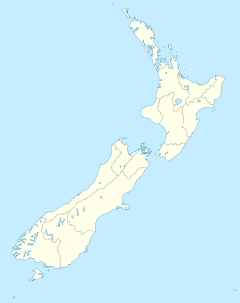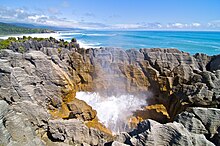Paparoa National Park
| Paparoa National Park | ||
|---|---|---|
| Pancake Rocks, Punakaiki | ||
|
|
||
| Location: | West Coast , New Zealand | |
| Specialty: | Punakaiki | |
| Surface: | 300 km² | |
| Founding: | 1987 | |
| Address: | Paparoa National Park Visitor Center Main Road, Punakaiki PO Box 1 Punakaiki Tel. 64 3 731 1895 |
|
The Paparoa National Park covers a 300 km² large area on the west coast of New Zealand's South Island . The park protects very different types of biotopes on a relatively small area from the coast of the Tasman Sea to the peaks of the New Zealand Alps (Southern Alps) . It was founded in 1987 as the country's 11th national park to protect the region's sensitive ecosystem from overexploitation by mining and forestry.

The special landscape of the Paparoa National Park is the result of the limestone , which is the dominant rock in the region. Since it can be worn away by natural erosion more easily than other stones , you will find bizarre rock formations, deep canyons and various caves in the park. Geological formations of particular importance are the so-called Pancake Rocks on the coast and the Paparoa Karst .
Inland, the area of the national park is mainly covered by coastal rainforest ; Deciduous trees, palm trees, climbing plants and ferns form a dense jungle here. A mild climate with very large amounts of precipitation favors the subtropical vegetation of the lower elevations. Due to the many different types of soil, the trees are more diverse than most other regions of New Zealand. There are many Nikau palm trees, especially in the valley of the Pororari River . The wildlife of Paparoa National Park is dominated by a variety of native bird species, including the kiwi . The western petrel is a species endemic to the park .
The area is accessed by State Highway 6 , which runs along the coast and is where the only places Punakaiki , Te Miko , Pahautane and Tiromoana are.
See also
Web links
- Department of Conservation (English)
- natureandco.co.nz (English)


